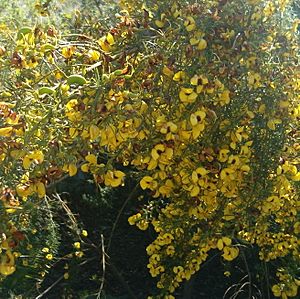Honeybush facts for kids
Quick facts for kids Honeybush |
|
|---|---|
 |
|
| Cyclopia meyeriana | |
| Scientific classification |
|
| Kingdom: | Plantae |
| Clade: | Tracheophytes |
| Clade: | Angiosperms |
| Clade: | Eudicots |
| Clade: | Rosids |
| Order: | Fabales |
| Family: | Fabaceae |
| Tribe: | Podalyrieae |
| Genus: | Cyclopia Vent. |
| Sections and species | |
|
See text |
|
 |
|
| Cyclopia is endemic to South Africa. | |
| Synonyms | |
|
|
Cyclopia, also known as honeybush, is a group of about 20 types of flowering plants. These plants belong to the legume family, called Fabaceae. They are famous for their sweet-smelling flowers, which is why they are called honeybush. In Afrikaans, people call them heuningbos.
A French botanist named Étienne Pierre Ventenat first described these plants in 1808. Another name, Ibbetsonia, was given to them two years later. However, it is now known to be the same plant. This name was given by John Sims to honor a physiologist named Agnes Ibbetson.
Contents
Growing and Using Honeybush Plants
The leaves of honeybush plants are often used to make special herbal teas. These plants grow only in small areas in the southwest and southeast parts of South Africa. They are quite similar to another popular South African plant called rooibos. Both honeybush and rooibos are sometimes called types of red tea.
Honeybush gets its name because its flowers smell like sweet honey. The tea made from honeybush tastes a bit like rooibos tea, but it's usually a little sweeter. In some country areas, people used to keep a pot of honeybush tea simmering on the stove all day. This would make the whole house smell wonderful! Unlike regular tea made from Camellia sinensis, honeybush tea does not get bitter even if it simmers for a long time.
There are many different kinds of honeybush plants found in the wild. About four or five of these are commonly used at home or sold commercially. Some of the well-known types include:
- Cyclopia intermedia: This one is called 'bergtee' (mountain tea). You can find it between Port Elizabeth and the Langkloof area.
- Cyclopia genistoides: Known as 'kustee' (coastal tea). It mostly grows in the Western Cape near Yzerfontein and Darling. It can also grow well in the South Cape if planted there.
- Cyclopia maculata: This type grows in the Outeniqua area, close to George.
- Cyclopia sessiliflora: Called 'Heidelberg-tee'. It's named after the town Heidelberg in South Africa, where it grows in the local mountains.
- Cyclopia subternata: Known as 'vleitee' (marshland tea) or 'valleitee' (valley tea).
- Cyclopia longifolia
Some honeybush types can be grown on farms, but others are harder to cultivate. These wild types must be collected from where they grow naturally. It can be tricky to figure out what their seeds need to sprout. Some seeds have special parts called elaiosomes. This might mean they need certain ants or birds to help them spread.
Cyclopia intermedia (mountain tea) is one of the types harvested in the Kouga mountains. It grows there naturally. After being harvested or after a fire, mountain tea plants can grow back within three years. Because of this, only about one-third of the mountain's tea plants are ready for harvesting each year. This helps make sure there's always more tea for the future.
Mountain tea and valley tea plants usually flower in September or October. Coastal tea plants, however, flower earlier, in May or June.
How Honeybush Tea is Made
There are two main ways to prepare honeybush for making tea.
In the traditional way, workers pick the leaves from the bush. Then, they cut and bruise the leaves, often using machines. After that, the leaves are left in the sun to change color and flavor. This process is called oxidation.
The modern way uses machines in factories. The leaves are put into large, rotating tanks that are heated to about 70–90 °C. The leaves stay in these tanks for two to three days to oxidize. After this, the leaves are dried using air.
Once the leaves are dry, they are sorted and graded based on how they will be used:
- Super Fine: This type is mostly used for small tea bags that have a string and tag.
- Regular Fine: This is often used for tea bags that "swim" in the cup or for loose tea.
- Coarse: This type is usually used for loose tea that you brew in a pot.
Healthy Compounds in Honeybush
Honeybush tea has very little tannin, which is a substance that can make tea taste bitter. It contains many healthy compounds. These include:
- isoflavones
- flavones
- cinnamic acids
- coumestans
- xanthonoids
- mangiferin and isomangiferin (found in Cyclopia subternata)
Images for kids
See also
 In Spanish: Cyclopia para niños
In Spanish: Cyclopia para niños


